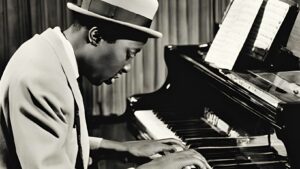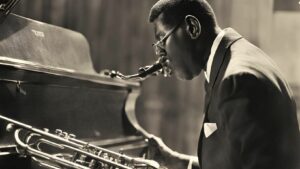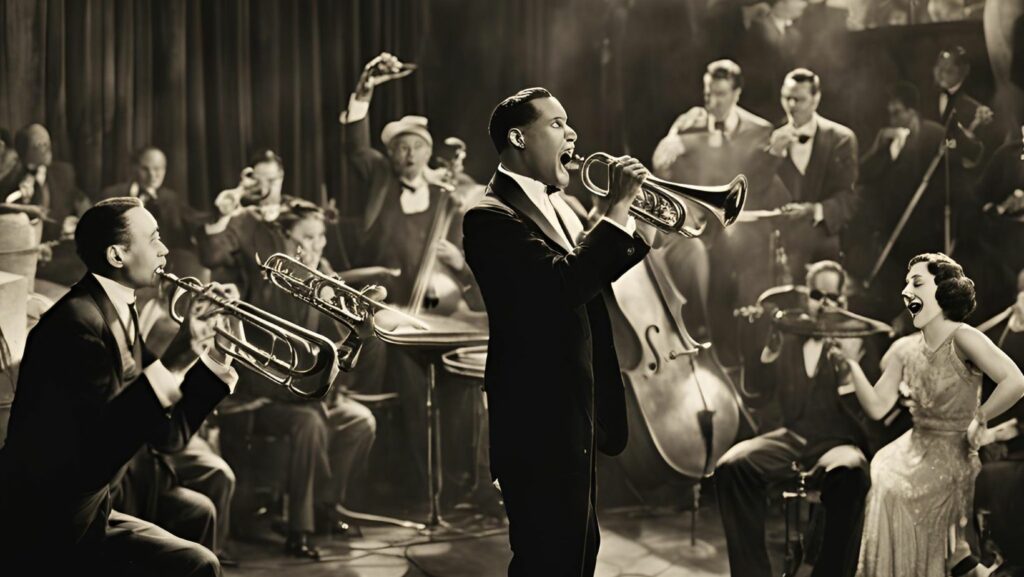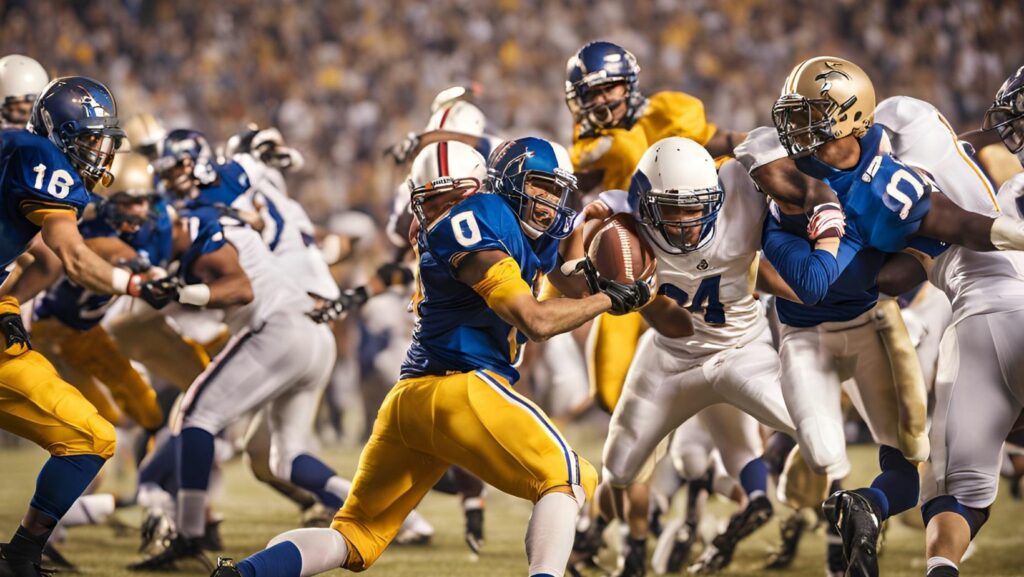Entertainment in the 1920s
- Cultural Revolution: The 1920s, known as the “Roaring Twenties,” marked a significant cultural shift in America, combining creativity and a quest for liberation after World War I.
- Jazz Dominance: Jazz music, characterized by its improvisational style and influential artists like Louis Armstrong and Duke Ellington, became the defining sound of the decade and catalyzed social change.
- Cinema Transformation: The transition from silent films to talkies in 1927, highlighted by “The Jazz Singer,” revolutionized the film industry, establishing Hollywood as the prime entertainment hub.
- Dance Trends: Energetic dance styles such as the Charleston and the Black Bottom emerged, allowing individuals to express themselves and break societal norms in vibrant dance halls.
- Theatre Expansion: Broadway experienced a significant boom with innovative musicals blending music and social commentary, while vaudeville showcased diverse acts, enriching live entertainment.
- Radio’s Impact: Radio broadcasting transformed entertainment access, popularizing jazz and creating a sense of community through shared live performances and programs, while also reshaping consumer culture through advertising.
The 1920s, often dubbed the “Roaring Twenties,” marked a vibrant shift in American culture and entertainment. This decade was defined by a surge in creativity and innovation, as people sought new ways to escape the aftermath of World War I. Jazz music filled the air, dance halls buzzed with energy, and the silver screen began to captivate audiences like never before.
From the rise of flappers and speakeasies to the advent of talkies, the entertainment landscape transformed dramatically. This era not only celebrated liberation and self-expression but also laid the groundwork for modern entertainment as we know it today. Exploring the diverse forms of entertainment that flourished during this time reveals a fascinating tapestry of social change and artistic evolution.
Overview of Entertainment in the 1920s
Entertainment in the 1920s experienced dramatic evolution, driven by social change and technological advancements. Jazz music dominated the scene, becoming the defining sound of the era. Artists like Louis Armstrong and Duke Ellington gained widespread popularity, captivating audiences in clubs and dance halls.
Dance styles such as the Charleston and the Black Bottom flourished, encouraging rhythmic movement and exuberance. Dance halls filled with crowds eager to embrace the energetic beats, reflecting the decade’s spirit of freedom and fun.
 Cinema transformed during this period, with the transition from silent films to talkies. The introduction of sound revolutionized the film industry, leading to iconic movies like “The Jazz Singer” in 1927. The rise of Hollywood established it as the entertainment capital, drawing aspiring actors and filmmakers.
Cinema transformed during this period, with the transition from silent films to talkies. The introduction of sound revolutionized the film industry, leading to iconic movies like “The Jazz Singer” in 1927. The rise of Hollywood established it as the entertainment capital, drawing aspiring actors and filmmakers.
The emergence of flappers symbolized the cultural shift. Young women challenged social norms by wearing shorter hemlines, bobbing their hair, and expressing themselves through music and dance. Speakeasies, hidden bars serving alcohol during Prohibition, became hotspots for socializing, music, and dance.
The influence of mass media expanded, with radio broadcasts beginning to reach households. Radio provided access to live performances and news, connecting audiences to the vibrant cultural landscape.
Overall, entertainment in the 1920s encapsulated a period of indulgence, creativity, and social progress. This dynamic decade reshaped artistic expression and laid the groundwork for future cultural developments.
Cinema and Film Industry
The 1920s marked a pivotal time for cinema, transforming the film industry and shaping popular culture. This decade witnessed remarkable advancements in filmmaking techniques and technology, leading to a significant evolution from silent films to the groundbreaking era of talkies.
The Rise of Silent Films
Silent films dominated the early part of the 1920s, capturing the imagination of audiences worldwide. Iconic actors like Charlie Chaplin and Buster Keaton became household names, known for their expressive performances that transcended language barriers. The era’s signature films, such as “The Cabinet of Dr. Caligari” and “Nosferatu,” showcased the potential of visual storytelling and established cinema as a legitimate art form. Theuse of intertitles provided essential dialogue, guiding viewers through intricate plots while vibrant cinematography contributed to the overall aesthetic.
The Advent of Talkies
The introduction of synchronized sound transformed the film landscape starting in 1927. “The Jazz Singer” pioneered this new era, combining spoken dialogue with music, captivating audiences and signaling the decline of silent films. The success of talkies led to a rapid shift in filmmaking practices, as studios rushed to adapt their productions to include sound. This evolution not only enhanced storytelling but also gave rise to a new generation of actors, such as Al Jolson, who thrived in this dynamic environment. The surge in talkies further solidified Hollywood’s status as the entertainment capital, reshaping not just cinema but the entire entertainment industry as it embraced the power of sound and music.
Music and Dance Trends
The 1920s served as a vibrant stage for music and dance, heavily influenced by the cultural changes of the Roaring Twenties. Jazz music not only defined the decade but also became the heartbeat of social gatherings and entertainment venues.
Jazz and the Roaring Twenties
 Jazz music emerged as the dominant genre during the 1920s, characterized by its improvisational style and infectious rhythms. Artists like Louis Armstrong and Duke Ellington gained immense popularity, revolutionizing the music scene.
Jazz music emerged as the dominant genre during the 1920s, characterized by its improvisational style and infectious rhythms. Artists like Louis Armstrong and Duke Ellington gained immense popularity, revolutionizing the music scene.
Jazz clubs and speakeasies flourished, offering a lively atmosphere for audiences to dance and socialize. The genre’s roots in African American culture resonated with the spirit of freedom and self-expression sought by many during this time. Key recordings and performances showcased the innovation of jazz, solidifying its place as a cultural landmark.
Popular Dance Styles
The 1920s introduced numerous dance styles that captivated the public’s imagination. Dances like the Charleston, characterized by its energetic footwork and flapper-inspired moves, became wildly popular in dance halls. The Black Bottom, another lively dance, featured rhythmic steps and hip-shaking movements, reflecting the carefree attitude of the era. These dance styles encouraged social interaction and broke down conservative societal norms, allowing individuals to express themselves freely. The combination of jazz music and innovative dance steps created an exhilarating entertainment landscape, influencing future generations of dancers and musicians alike.
Theatre and Live Performances
The 1920s saw a vibrant expansion in theatre and live performances, reflecting the era’s cultural dynamism. Audiences flocked to a variety of shows, each offering a taste of the innovative spirit of the Roaring Twenties.
The Broadway Boom
The Broadway stage experienced an unprecedented boom during the 1920s. The rise of new musicals and plays transformed New York’s theatre district into a cultural epicenter. Productions like “Show Boat,” which debuted in 1927, blended music, drama, and social commentary, captivating audiences and introducing serious themes to musical theatre. The era also saw the emergence of notable stars such as Ethel Waters and Al Jolson, who drew crowds with their unforgettable performances. The integration of jazz-infused music into Broadway productions marked a significant shift, aligning theatre with the popular culture of the time.
Vaudeville and Variety Shows
Vaudeville and variety shows flourished as a popular form of entertainment in the 1920s. These multi-act performances showcased a diverse range of acts, including comedians, musicians, dancers, and magicians. The format appealed to all demographics, making it a staple of American entertainment. Venues such as the Palace Theatre in New York became renowned for hosting top-tier vaudeville acts. Performers like Buster Keaton and the Three Stooges gained fame during this time, captivating audiences with their unique talents. This vibrant performance style not only entertained but also influenced later forms of television variety shows, paving the way for future entertainment trends.
Impact of Radio and Broadcasting
The 1920s marked a transformative era for communication and entertainment due to the advent of radio and broadcasting. Radio emerged as a powerful medium, revolutionizing how people accessed news, music, and entertainment. By 1922, over 500 radio stations were broadcasting across the United States, connecting audiences in unprecedented ways.
Broadcasting facilitated the widespread dissemination of jazz music, allowing artists like Louis Armstrong and Duke Ellington to reach national audiences. Radio programs featured live performances, bringing the vibrancy of jazz into homes and contributing to its popularity. This accessibility transformed jazz from a regional phenomenon into a national sensation.
Public radio programs provided news updates and entertainment, keeping listeners informed and engaged. Programs such as “Amos ‘n’ Andy” blended humor and social commentary, resonating with diverse audiences. The ability to share stories and experiences fostered a sense of community across the country.
Commercial radio also introduced advertising, shaping consumer culture. Businesses leveraged the medium to promote products and services, integrating entertainment into marketing strategies. This shift not only influenced consumer habits but also laid the groundwork for modern advertising practices.
The impact of radio and broadcasting during the 1920s was profound. It transformed entertainment access, amplified the popularity of jazz, fostered community engagement, and revolutionized advertising strategies, leaving a lasting legacy on the media landscape.
Cultural Influences and Changes
Cultural influences in the 1920s reshaped entertainment landscapes, reflecting societal shifts and advancements. Jazz music dominated this decade, driven by remarkable artists. Louis Armstrong and Duke Ellington introduced innovative sounds that resonated across America. Jazz became synonymous with liberation, inspiring the creation of vibrant dance styles. The Charleston and the Black Bottom invited enthusiastic participation, breaking down traditional barriers and encouraging social interaction.
The 1920s marked a turning point in cinema; silent films were the mainstay before synchronized sound transformed the industry. Iconic figures like Charlie Chaplin and Buster Keaton established their legacies with expressive performances in silent films. Landmark productions such as “The Cabinet of Dr. Caligari” and “Nosferatu” pushed visual storytelling boundaries. The release of “The Jazz Singer” in 1927 heralded the arrival of talkies, revolutionizing film narratives and paving the way for future cinematic innovations. This change in production not only elevated storytelling techniques but also propelled Hollywood to become the epicenter of entertainment.
The theatrical scene thrived, showcasing a mix of old and new artistic expressions. Broadway enjoyed an unprecedented boom, with productions like “Show Boat” fusing music, drama, and social commentary. This integration captivated audiences while addressing serious themes. Notable performers like Ethel Waters and Al Jolson gained fame for their unforgettable stage presence. Vaudeville and variety shows flourished, uniting diverse acts and inspiring future television programs.
Radio also played a crucial role in expanding entertainment access. By 1922, over 500 radio stations broadcast across the United States, democratizing music and news. This technology brought jazz into homes, elevating artists to national prominence. Public radio programs fostered community connections and provided both news and entertainment. Meanwhile, commercial radio introduced advertising, reshaping consumer culture and laying foundations for modern marketing.
The 1920s proved instrumental in establishing modern entertainment forms. The convergence of music, dance, cinema, and radio reflected broader cultural changes while promoting self-expression and reinvention. This decade forged connections among artists, audiences, and emerging mediums, shaping a vibrant cultural landscape.
A Spirit of Creativity and Liberation That Resonated Deeply With Society
The 1920s stand out as a transformative decade that reshaped the entertainment landscape in profound ways. With the rise of jazz music and the advent of talkies, this era fostered a spirit of creativity and liberation that resonated deeply with society. The vibrant dance halls and innovative theatrical productions captivated audiences and encouraged self-expression.
As radio broadcasting emerged, it connected people across the nation, further solidifying the cultural shifts taking place. The combination of these elements not only defined the Roaring Twenties but also laid the groundwork for modern entertainment. This dynamic period remains a testament to the power of artistic expression and social change, influencing generations to come.



